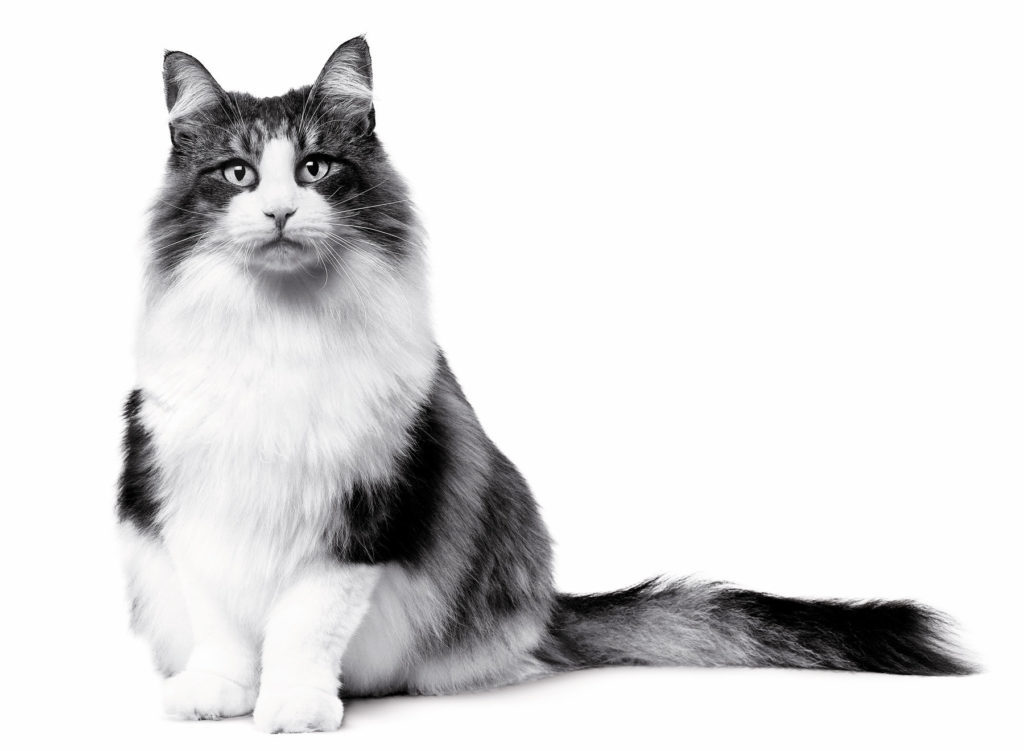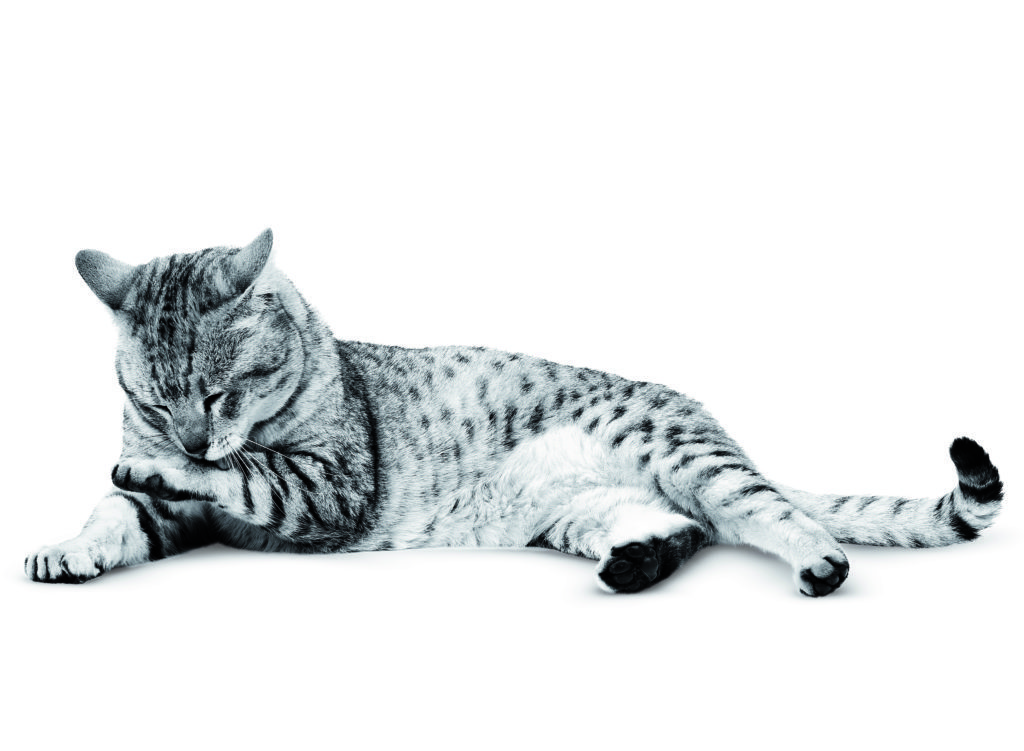Brushing the coat, tooth-brushing, keeping an eye on claw length, eye discharges, and possibly ear cleaning are simple gestures which contribute to your cat’s overall physical wellbeing.
If well trained as a kitten, an adult cat should be used to these few gestures of basic care. If you’re having trouble with your cat accepting these practices, veterinary staff and other feline health professionals (such as breeders and groomers) will be able to advise you.
Removing dead hair from the coat
Apart from looking good, a brushed coat is more free of dead hair, meaning less is available to be removed by your cat while grooming.
Grooming activity, constituting an average of 30% of your cat’s time leads to ingestion of shed hair, leading to hairballs and sometimes digestive issues.
Indoor cats, who moult throughout the year are more predisposed to hairballs; a 4kg cat can eliminate a daily volume of 10cm3 of hair through their faeces!
Cats with longer hair such as the Persian require careful untangling of the coat with a good-quality comb every day. The coat should then be brushed and aired. In short and flat hair cats (such as the Siamese or the Abyssinian), a few firm strokes of the hand is sometimes all that’s needed.
Passing a soft brush through the coat once a week is recommended for a medium-length coat or hair with a thick undercoat (such as in the Maine Coon or Exotic Shorthair respectively).
The coat may be described by some as a mirror of dietary health. A protein deficit or deficiency of certain amino-acids (the building-blocks of protein) may accelerate hair loss, slow down hair growth and be responsible for lacklustre or brittle hair.
The coat’s natural beauty may be strengthened by a diet which focuses on Health Nutrition™. These types of diets contain specific nutrients which are indispensable in favouring coat growth, gloss and renewal.
Things to keep an eye on
Discharges may build up in the inside corner of the eye. Clean these away gently with a moistened, clean soft cloth or tissue. Your cat should neither have a profuse ocular discharge or a runny nose, which can be indicators of upper respiratory problems.
For the best oral hygiene possible, daily tooth-brushing (to prevent plaque build-up and tartar formation) is essential. Palatable toothpastes made for cats can be applied to the teeth using a specially designed brush (or a folded compress where the brush is not accepted).
Monitor your cat’s dentition on an ongoing basis as periodontal problems are common; indeed, 2 out of 3 cats are affected by dental issues. A dry Health Nutrition™ food formulated to maintain optimal oral hygiene should also be considered.
Such a diet will effectively help limit tartar formation by a mechanical brushing effect of the kibble against the teeth. Specific active agents also capture salivary calcium and prevent its deposition in the form of tartar.
Your cat’s ears should remain clean and free of foreign bodies or obstructions. Your vet or nurse may advise you to use some cotton-wool (not cotton buds!) and a formulated ear cleaner to remove waxy debris from the ear canal. Be sure to discuss this with them and don’t be tempted to use water when cleaning your cat’s ears at home.
Claws
Keeping an eye on the length of your cat’s claws and occasionally clipping them when necessary is not a bad practice. On the contrary, advantages not only include reducing potential damage to your furniture but damage which might be done to the pads of their paws should the claws over-grow.
Many ask their vet or a groomer to undertake nail clipping, however if you’d prefer you can learn to use specifically designed clippers or scissors yourself. Often a towel can be used to wrap up your cat, leaving only the paw to be clipped exposed.
Each claw can be exposed by pressing on the relevant phalanx (‘finger’) and clipped carefully below the level of the pink ‘quick’ which contains the cat’s blood vessels and nerve endings. If you’re interested in learning this technique, your vet will be able to demonstrate and advise you.
Having a bath?
Some cats are open to being bathed, particularly when trained to do so from a young age. While this practice is more typical of show cats, any cat can undertake the practice and it can improve the condition of their skin and coat. Where certain dermatological problems are identified, bathing may be recommended.
Use specially formulated (not human) shampoo and be sure to bathe your cat in a relatively warm room. If in a sink or bath, use an anti-skid mat and a few centimetres of water, gradually moistening the coat before applying the shampoo and working it in to lather. Thorough rinsing is to be followed by gentle rubbing with a towel. Be sure to keep your cat warm throughout.
For cats which are adverse to bathing, scentless powders equivalent to dry shampoos can be used as an alternative.
Vaccines and anti-parasitic treatment
Vaccination stimulates your cat to form immunity against potentially debilitating infectious diseases. ‘Cat flu’ (including Calicivirus and a Herpesvirus), Infectious Enteritis and Feline Leukemia can be vaccinated against.
Consult with your veterinarian as to the best approach and on-going schedule for booster vaccinations which will ensure the best continuing protection against these diseases.
Responsible pet ownership includes regular worming which will prevent an infestation of internal parasites. Your vet once again should prescribe a suitable wormer and administer it at the right frequency.
Where an infestation of fleas is also found, worming is likely to be more frequent as fleas are able to pass on tapeworms.
Some species of internal parasites can even be passed to man, further highlighting the importance of preventative treatment.
External parasites such as fleas and lice can also be detrimental. An anti-parasitic dispensed by your veterinarian will allow effective treatment and prevention of these parasites from as early as 2 months of age. It is also a good idea to treat other dogs and cats in the household and to select a product which treats your animal’s environment simultaneously.
Cat scratchers and trees
The damage a cat can inflict on soft furnishings is often a cause for their owner’s despair. These damages can be brought under control by way of providing your cat with alternatives.
A vertical scratcher for example or a cat tree (a wood ‘trunk’ covered with sisal with platforms and often hiding places) can provide your cat with a territory of their own.
This can provide an outlet for your cat to display climbing behaviour, find a post for observation and rest, and a safe apparatus to sharpen their claws on to their heart’s content.
WANT TO KNOW MORE?
Hopefully, this has helped to answer your question about cat hygiene. If you have any other questions about everyday cat care, your cat’s health, or other facts about your feline friend then we’d like to help – sign up to our newsletter below.